Business Strategy Analysis Report: HSBC's Macro and Micro Environment
VerifiedAdded on 2023/06/08
|15
|4962
|239
Report
AI Summary
This report provides a comprehensive analysis of HSBC's business strategy. It begins with an introduction to business strategy and its importance, followed by an analysis of the macro environment using models like stakeholder analysis, PESTLE, Ansoff's matrix, and SWOT. The report then evaluates HSBC's internal environment and capabilities using frameworks such as strategic capabilities, resource-based view, and McKinsey's 7S model. Furthermore, it implements Porter's five forces to assess the competitive forces within the market sector. Finally, the report applies various models, theories, and concepts to interpret strategic planning for HSBC, culminating in a strategic management plan that outlines strategic priorities and objectives. The report concludes with a summary of the key findings and a list of references.
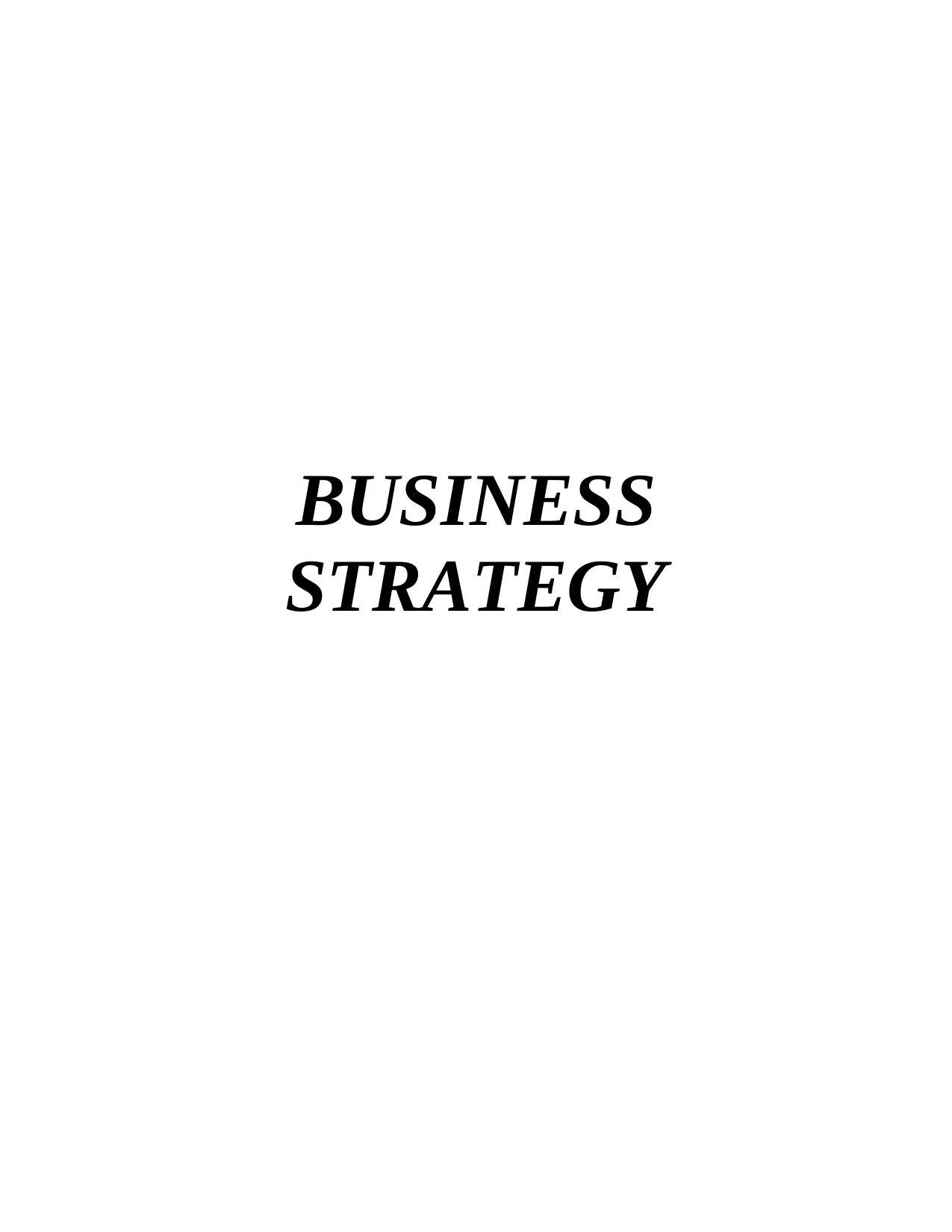
BUSINESS
STRATEGY
STRATEGY
Paraphrase This Document
Need a fresh take? Get an instant paraphrase of this document with our AI Paraphraser
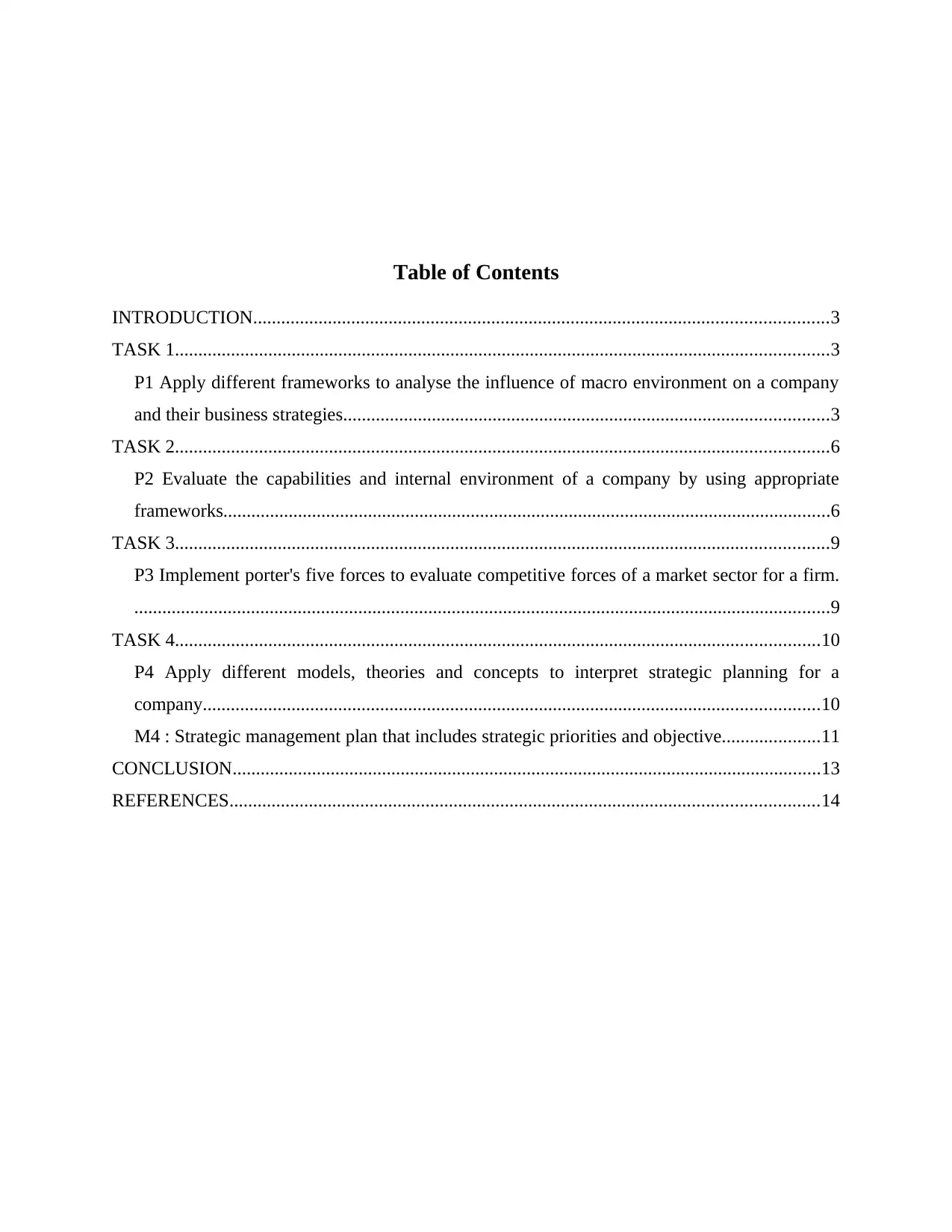
Table of Contents
INTRODUCTION...........................................................................................................................3
TASK 1............................................................................................................................................3
P1 Apply different frameworks to analyse the influence of macro environment on a company
and their business strategies........................................................................................................3
TASK 2............................................................................................................................................6
P2 Evaluate the capabilities and internal environment of a company by using appropriate
frameworks..................................................................................................................................6
TASK 3............................................................................................................................................9
P3 Implement porter's five forces to evaluate competitive forces of a market sector for a firm.
.....................................................................................................................................................9
TASK 4..........................................................................................................................................10
P4 Apply different models, theories and concepts to interpret strategic planning for a
company....................................................................................................................................10
M4 : Strategic management plan that includes strategic priorities and objective.....................11
CONCLUSION..............................................................................................................................13
REFERENCES..............................................................................................................................14
INTRODUCTION...........................................................................................................................3
TASK 1............................................................................................................................................3
P1 Apply different frameworks to analyse the influence of macro environment on a company
and their business strategies........................................................................................................3
TASK 2............................................................................................................................................6
P2 Evaluate the capabilities and internal environment of a company by using appropriate
frameworks..................................................................................................................................6
TASK 3............................................................................................................................................9
P3 Implement porter's five forces to evaluate competitive forces of a market sector for a firm.
.....................................................................................................................................................9
TASK 4..........................................................................................................................................10
P4 Apply different models, theories and concepts to interpret strategic planning for a
company....................................................................................................................................10
M4 : Strategic management plan that includes strategic priorities and objective.....................11
CONCLUSION..............................................................................................................................13
REFERENCES..............................................................................................................................14
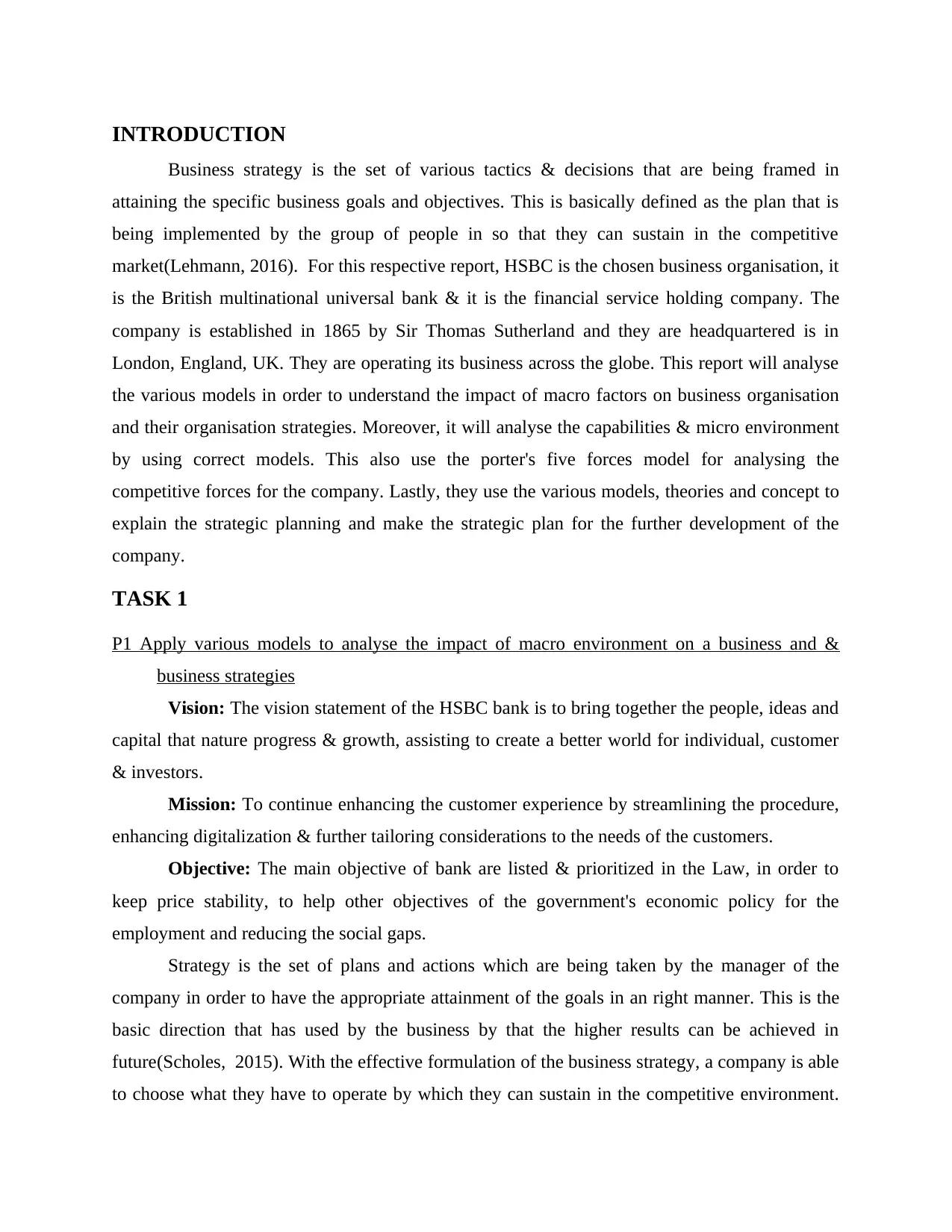
INTRODUCTION
Business strategy is the set of various tactics & decisions that are being framed in
attaining the specific business goals and objectives. This is basically defined as the plan that is
being implemented by the group of people in so that they can sustain in the competitive
market(Lehmann, 2016). For this respective report, HSBC is the chosen business organisation, it
is the British multinational universal bank & it is the financial service holding company. The
company is established in 1865 by Sir Thomas Sutherland and they are headquartered is in
London, England, UK. They are operating its business across the globe. This report will analyse
the various models in order to understand the impact of macro factors on business organisation
and their organisation strategies. Moreover, it will analyse the capabilities & micro environment
by using correct models. This also use the porter's five forces model for analysing the
competitive forces for the company. Lastly, they use the various models, theories and concept to
explain the strategic planning and make the strategic plan for the further development of the
company.
TASK 1
P1 Apply various models to analyse the impact of macro environment on a business and &
business strategies
Vision: The vision statement of the HSBC bank is to bring together the people, ideas and
capital that nature progress & growth, assisting to create a better world for individual, customer
& investors.
Mission: To continue enhancing the customer experience by streamlining the procedure,
enhancing digitalization & further tailoring considerations to the needs of the customers.
Objective: The main objective of bank are listed & prioritized in the Law, in order to
keep price stability, to help other objectives of the government's economic policy for the
employment and reducing the social gaps.
Strategy is the set of plans and actions which are being taken by the manager of the
company in order to have the appropriate attainment of the goals in an right manner. This is the
basic direction that has used by the business by that the higher results can be achieved in
future(Scholes, 2015). With the effective formulation of the business strategy, a company is able
to choose what they have to operate by which they can sustain in the competitive environment.
Business strategy is the set of various tactics & decisions that are being framed in
attaining the specific business goals and objectives. This is basically defined as the plan that is
being implemented by the group of people in so that they can sustain in the competitive
market(Lehmann, 2016). For this respective report, HSBC is the chosen business organisation, it
is the British multinational universal bank & it is the financial service holding company. The
company is established in 1865 by Sir Thomas Sutherland and they are headquartered is in
London, England, UK. They are operating its business across the globe. This report will analyse
the various models in order to understand the impact of macro factors on business organisation
and their organisation strategies. Moreover, it will analyse the capabilities & micro environment
by using correct models. This also use the porter's five forces model for analysing the
competitive forces for the company. Lastly, they use the various models, theories and concept to
explain the strategic planning and make the strategic plan for the further development of the
company.
TASK 1
P1 Apply various models to analyse the impact of macro environment on a business and &
business strategies
Vision: The vision statement of the HSBC bank is to bring together the people, ideas and
capital that nature progress & growth, assisting to create a better world for individual, customer
& investors.
Mission: To continue enhancing the customer experience by streamlining the procedure,
enhancing digitalization & further tailoring considerations to the needs of the customers.
Objective: The main objective of bank are listed & prioritized in the Law, in order to
keep price stability, to help other objectives of the government's economic policy for the
employment and reducing the social gaps.
Strategy is the set of plans and actions which are being taken by the manager of the
company in order to have the appropriate attainment of the goals in an right manner. This is the
basic direction that has used by the business by that the higher results can be achieved in
future(Scholes, 2015). With the effective formulation of the business strategy, a company is able
to choose what they have to operate by which they can sustain in the competitive environment.
⊘ This is a preview!⊘
Do you want full access?
Subscribe today to unlock all pages.

Trusted by 1+ million students worldwide
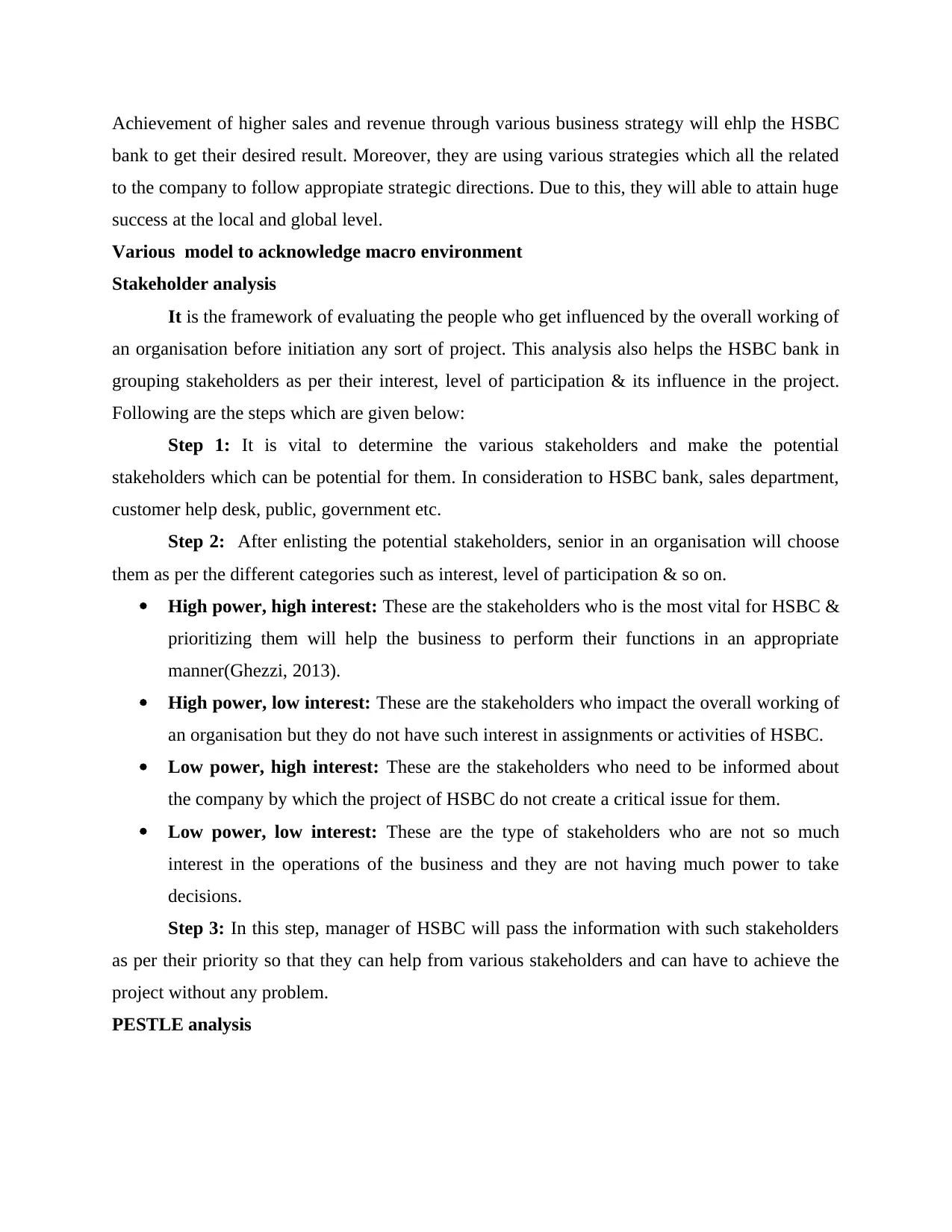
Achievement of higher sales and revenue through various business strategy will ehlp the HSBC
bank to get their desired result. Moreover, they are using various strategies which all the related
to the company to follow appropiate strategic directions. Due to this, they will able to attain huge
success at the local and global level.
Various model to acknowledge macro environment
Stakeholder analysis
It is the framework of evaluating the people who get influenced by the overall working of
an organisation before initiation any sort of project. This analysis also helps the HSBC bank in
grouping stakeholders as per their interest, level of participation & its influence in the project.
Following are the steps which are given below:
Step 1: It is vital to determine the various stakeholders and make the potential
stakeholders which can be potential for them. In consideration to HSBC bank, sales department,
customer help desk, public, government etc.
Step 2: After enlisting the potential stakeholders, senior in an organisation will choose
them as per the different categories such as interest, level of participation & so on.
High power, high interest: These are the stakeholders who is the most vital for HSBC &
prioritizing them will help the business to perform their functions in an appropriate
manner(Ghezzi, 2013).
High power, low interest: These are the stakeholders who impact the overall working of
an organisation but they do not have such interest in assignments or activities of HSBC.
Low power, high interest: These are the stakeholders who need to be informed about
the company by which the project of HSBC do not create a critical issue for them.
Low power, low interest: These are the type of stakeholders who are not so much
interest in the operations of the business and they are not having much power to take
decisions.
Step 3: In this step, manager of HSBC will pass the information with such stakeholders
as per their priority so that they can help from various stakeholders and can have to achieve the
project without any problem.
PESTLE analysis
bank to get their desired result. Moreover, they are using various strategies which all the related
to the company to follow appropiate strategic directions. Due to this, they will able to attain huge
success at the local and global level.
Various model to acknowledge macro environment
Stakeholder analysis
It is the framework of evaluating the people who get influenced by the overall working of
an organisation before initiation any sort of project. This analysis also helps the HSBC bank in
grouping stakeholders as per their interest, level of participation & its influence in the project.
Following are the steps which are given below:
Step 1: It is vital to determine the various stakeholders and make the potential
stakeholders which can be potential for them. In consideration to HSBC bank, sales department,
customer help desk, public, government etc.
Step 2: After enlisting the potential stakeholders, senior in an organisation will choose
them as per the different categories such as interest, level of participation & so on.
High power, high interest: These are the stakeholders who is the most vital for HSBC &
prioritizing them will help the business to perform their functions in an appropriate
manner(Ghezzi, 2013).
High power, low interest: These are the stakeholders who impact the overall working of
an organisation but they do not have such interest in assignments or activities of HSBC.
Low power, high interest: These are the stakeholders who need to be informed about
the company by which the project of HSBC do not create a critical issue for them.
Low power, low interest: These are the type of stakeholders who are not so much
interest in the operations of the business and they are not having much power to take
decisions.
Step 3: In this step, manager of HSBC will pass the information with such stakeholders
as per their priority so that they can help from various stakeholders and can have to achieve the
project without any problem.
PESTLE analysis
Paraphrase This Document
Need a fresh take? Get an instant paraphrase of this document with our AI Paraphraser
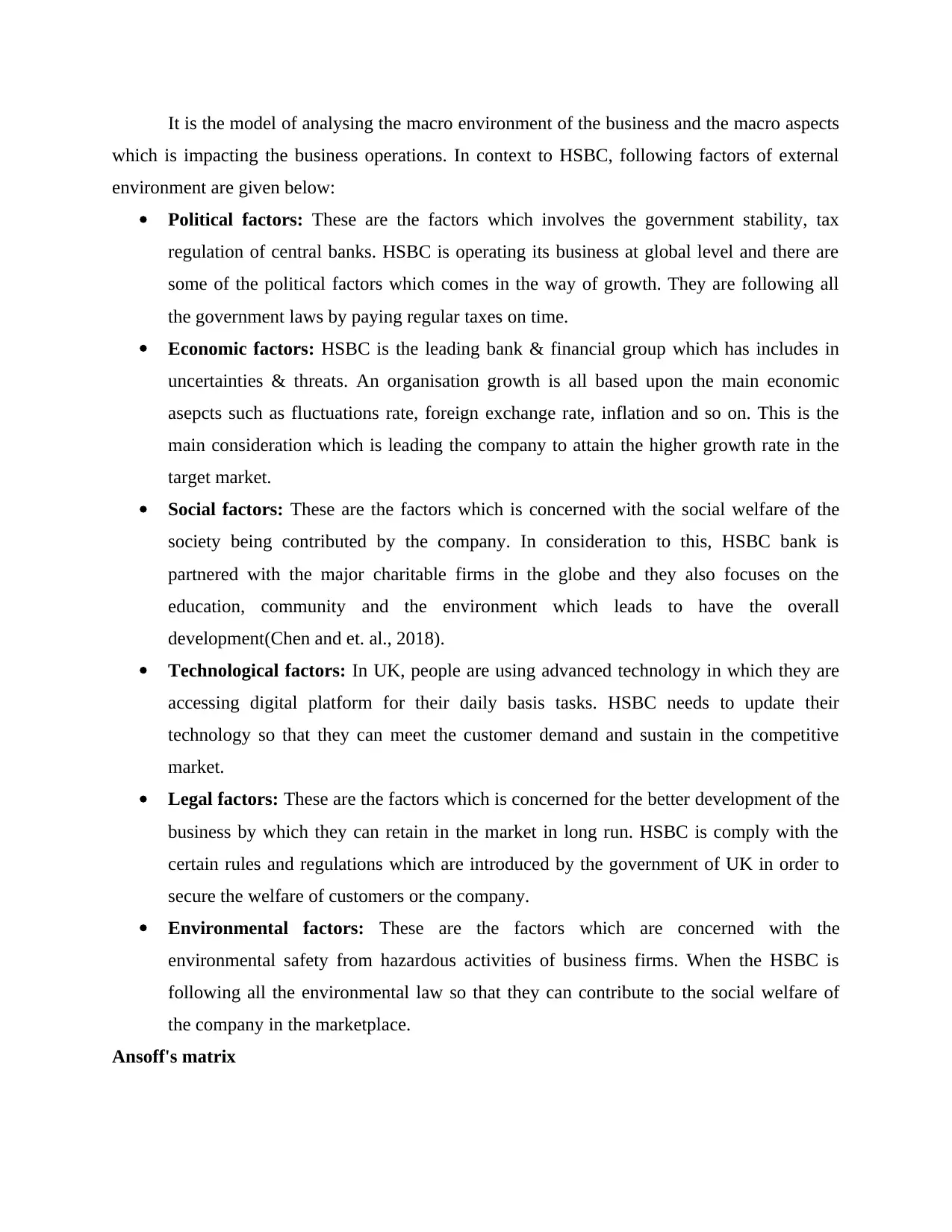
It is the model of analysing the macro environment of the business and the macro aspects
which is impacting the business operations. In context to HSBC, following factors of external
environment are given below:
Political factors: These are the factors which involves the government stability, tax
regulation of central banks. HSBC is operating its business at global level and there are
some of the political factors which comes in the way of growth. They are following all
the government laws by paying regular taxes on time.
Economic factors: HSBC is the leading bank & financial group which has includes in
uncertainties & threats. An organisation growth is all based upon the main economic
asepcts such as fluctuations rate, foreign exchange rate, inflation and so on. This is the
main consideration which is leading the company to attain the higher growth rate in the
target market.
Social factors: These are the factors which is concerned with the social welfare of the
society being contributed by the company. In consideration to this, HSBC bank is
partnered with the major charitable firms in the globe and they also focuses on the
education, community and the environment which leads to have the overall
development(Chen and et. al., 2018).
Technological factors: In UK, people are using advanced technology in which they are
accessing digital platform for their daily basis tasks. HSBC needs to update their
technology so that they can meet the customer demand and sustain in the competitive
market.
Legal factors: These are the factors which is concerned for the better development of the
business by which they can retain in the market in long run. HSBC is comply with the
certain rules and regulations which are introduced by the government of UK in order to
secure the welfare of customers or the company.
Environmental factors: These are the factors which are concerned with the
environmental safety from hazardous activities of business firms. When the HSBC is
following all the environmental law so that they can contribute to the social welfare of
the company in the marketplace.
Ansoff's matrix
which is impacting the business operations. In context to HSBC, following factors of external
environment are given below:
Political factors: These are the factors which involves the government stability, tax
regulation of central banks. HSBC is operating its business at global level and there are
some of the political factors which comes in the way of growth. They are following all
the government laws by paying regular taxes on time.
Economic factors: HSBC is the leading bank & financial group which has includes in
uncertainties & threats. An organisation growth is all based upon the main economic
asepcts such as fluctuations rate, foreign exchange rate, inflation and so on. This is the
main consideration which is leading the company to attain the higher growth rate in the
target market.
Social factors: These are the factors which is concerned with the social welfare of the
society being contributed by the company. In consideration to this, HSBC bank is
partnered with the major charitable firms in the globe and they also focuses on the
education, community and the environment which leads to have the overall
development(Chen and et. al., 2018).
Technological factors: In UK, people are using advanced technology in which they are
accessing digital platform for their daily basis tasks. HSBC needs to update their
technology so that they can meet the customer demand and sustain in the competitive
market.
Legal factors: These are the factors which is concerned for the better development of the
business by which they can retain in the market in long run. HSBC is comply with the
certain rules and regulations which are introduced by the government of UK in order to
secure the welfare of customers or the company.
Environmental factors: These are the factors which are concerned with the
environmental safety from hazardous activities of business firms. When the HSBC is
following all the environmental law so that they can contribute to the social welfare of
the company in the marketplace.
Ansoff's matrix
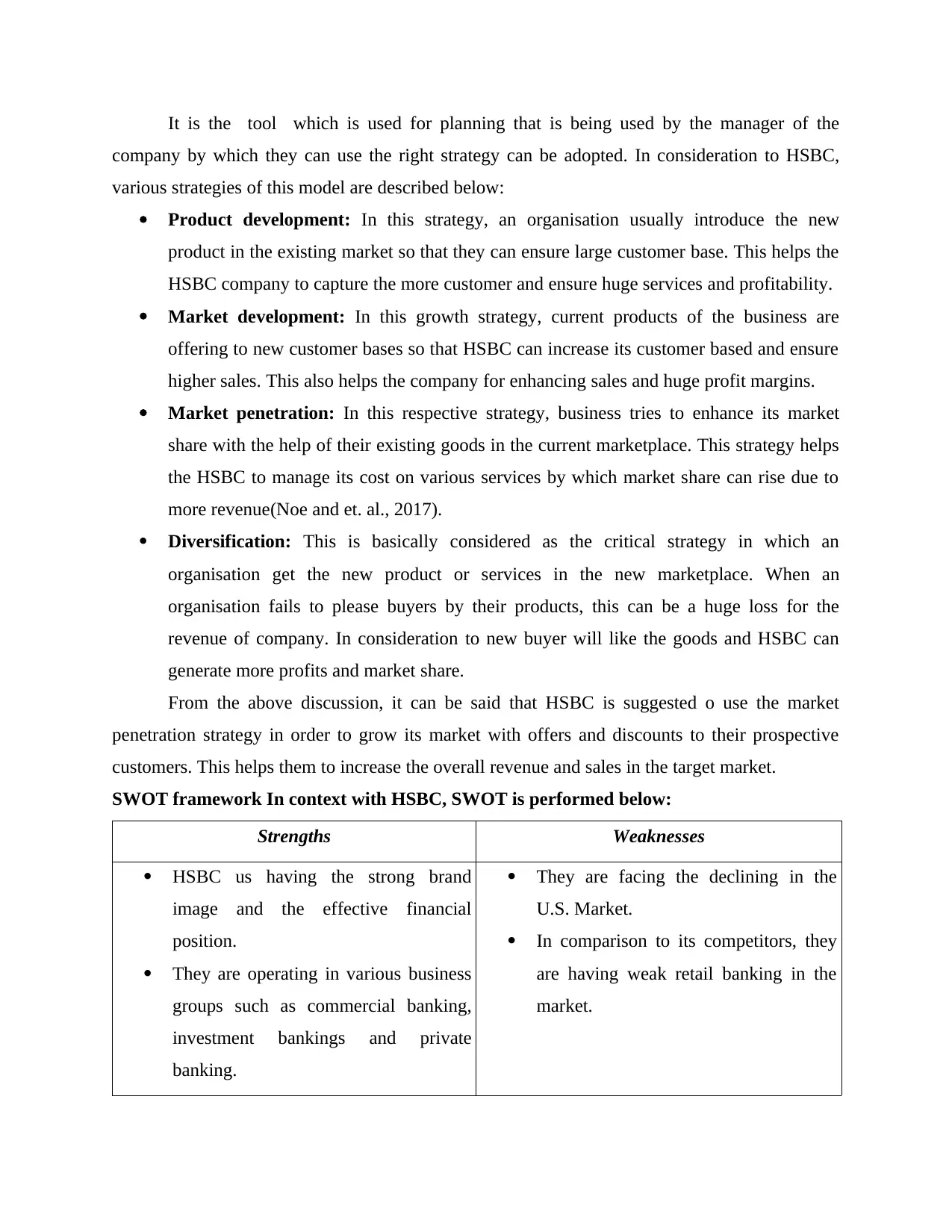
It is the tool which is used for planning that is being used by the manager of the
company by which they can use the right strategy can be adopted. In consideration to HSBC,
various strategies of this model are described below:
Product development: In this strategy, an organisation usually introduce the new
product in the existing market so that they can ensure large customer base. This helps the
HSBC company to capture the more customer and ensure huge services and profitability.
Market development: In this growth strategy, current products of the business are
offering to new customer bases so that HSBC can increase its customer based and ensure
higher sales. This also helps the company for enhancing sales and huge profit margins.
Market penetration: In this respective strategy, business tries to enhance its market
share with the help of their existing goods in the current marketplace. This strategy helps
the HSBC to manage its cost on various services by which market share can rise due to
more revenue(Noe and et. al., 2017).
Diversification: This is basically considered as the critical strategy in which an
organisation get the new product or services in the new marketplace. When an
organisation fails to please buyers by their products, this can be a huge loss for the
revenue of company. In consideration to new buyer will like the goods and HSBC can
generate more profits and market share.
From the above discussion, it can be said that HSBC is suggested o use the market
penetration strategy in order to grow its market with offers and discounts to their prospective
customers. This helps them to increase the overall revenue and sales in the target market.
SWOT framework In context with HSBC, SWOT is performed below:
Strengths Weaknesses
HSBC us having the strong brand
image and the effective financial
position.
They are operating in various business
groups such as commercial banking,
investment bankings and private
banking.
They are facing the declining in the
U.S. Market.
In comparison to its competitors, they
are having weak retail banking in the
market.
company by which they can use the right strategy can be adopted. In consideration to HSBC,
various strategies of this model are described below:
Product development: In this strategy, an organisation usually introduce the new
product in the existing market so that they can ensure large customer base. This helps the
HSBC company to capture the more customer and ensure huge services and profitability.
Market development: In this growth strategy, current products of the business are
offering to new customer bases so that HSBC can increase its customer based and ensure
higher sales. This also helps the company for enhancing sales and huge profit margins.
Market penetration: In this respective strategy, business tries to enhance its market
share with the help of their existing goods in the current marketplace. This strategy helps
the HSBC to manage its cost on various services by which market share can rise due to
more revenue(Noe and et. al., 2017).
Diversification: This is basically considered as the critical strategy in which an
organisation get the new product or services in the new marketplace. When an
organisation fails to please buyers by their products, this can be a huge loss for the
revenue of company. In consideration to new buyer will like the goods and HSBC can
generate more profits and market share.
From the above discussion, it can be said that HSBC is suggested o use the market
penetration strategy in order to grow its market with offers and discounts to their prospective
customers. This helps them to increase the overall revenue and sales in the target market.
SWOT framework In context with HSBC, SWOT is performed below:
Strengths Weaknesses
HSBC us having the strong brand
image and the effective financial
position.
They are operating in various business
groups such as commercial banking,
investment bankings and private
banking.
They are facing the declining in the
U.S. Market.
In comparison to its competitors, they
are having weak retail banking in the
market.
⊘ This is a preview!⊘
Do you want full access?
Subscribe today to unlock all pages.

Trusted by 1+ million students worldwide
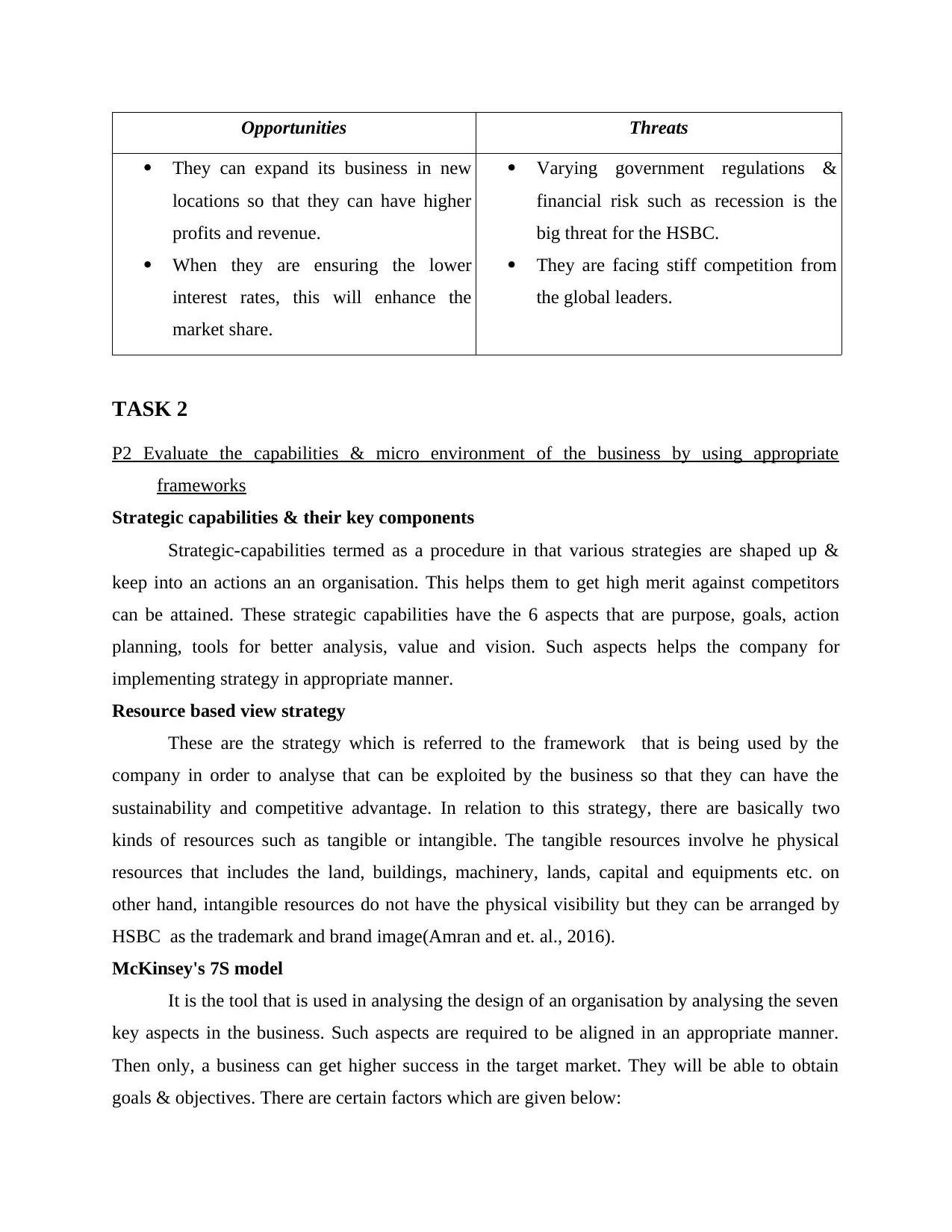
Opportunities Threats
They can expand its business in new
locations so that they can have higher
profits and revenue.
When they are ensuring the lower
interest rates, this will enhance the
market share.
Varying government regulations &
financial risk such as recession is the
big threat for the HSBC.
They are facing stiff competition from
the global leaders.
TASK 2
P2 Evaluate the capabilities & micro environment of the business by using appropriate
frameworks
Strategic capabilities & their key components
Strategic-capabilities termed as a procedure in that various strategies are shaped up &
keep into an actions an an organisation. This helps them to get high merit against competitors
can be attained. These strategic capabilities have the 6 aspects that are purpose, goals, action
planning, tools for better analysis, value and vision. Such aspects helps the company for
implementing strategy in appropriate manner.
Resource based view strategy
These are the strategy which is referred to the framework that is being used by the
company in order to analyse that can be exploited by the business so that they can have the
sustainability and competitive advantage. In relation to this strategy, there are basically two
kinds of resources such as tangible or intangible. The tangible resources involve he physical
resources that includes the land, buildings, machinery, lands, capital and equipments etc. on
other hand, intangible resources do not have the physical visibility but they can be arranged by
HSBC as the trademark and brand image(Amran and et. al., 2016).
McKinsey's 7S model
It is the tool that is used in analysing the design of an organisation by analysing the seven
key aspects in the business. Such aspects are required to be aligned in an appropriate manner.
Then only, a business can get higher success in the target market. They will be able to obtain
goals & objectives. There are certain factors which are given below:
They can expand its business in new
locations so that they can have higher
profits and revenue.
When they are ensuring the lower
interest rates, this will enhance the
market share.
Varying government regulations &
financial risk such as recession is the
big threat for the HSBC.
They are facing stiff competition from
the global leaders.
TASK 2
P2 Evaluate the capabilities & micro environment of the business by using appropriate
frameworks
Strategic capabilities & their key components
Strategic-capabilities termed as a procedure in that various strategies are shaped up &
keep into an actions an an organisation. This helps them to get high merit against competitors
can be attained. These strategic capabilities have the 6 aspects that are purpose, goals, action
planning, tools for better analysis, value and vision. Such aspects helps the company for
implementing strategy in appropriate manner.
Resource based view strategy
These are the strategy which is referred to the framework that is being used by the
company in order to analyse that can be exploited by the business so that they can have the
sustainability and competitive advantage. In relation to this strategy, there are basically two
kinds of resources such as tangible or intangible. The tangible resources involve he physical
resources that includes the land, buildings, machinery, lands, capital and equipments etc. on
other hand, intangible resources do not have the physical visibility but they can be arranged by
HSBC as the trademark and brand image(Amran and et. al., 2016).
McKinsey's 7S model
It is the tool that is used in analysing the design of an organisation by analysing the seven
key aspects in the business. Such aspects are required to be aligned in an appropriate manner.
Then only, a business can get higher success in the target market. They will be able to obtain
goals & objectives. There are certain factors which are given below:
Paraphrase This Document
Need a fresh take? Get an instant paraphrase of this document with our AI Paraphraser
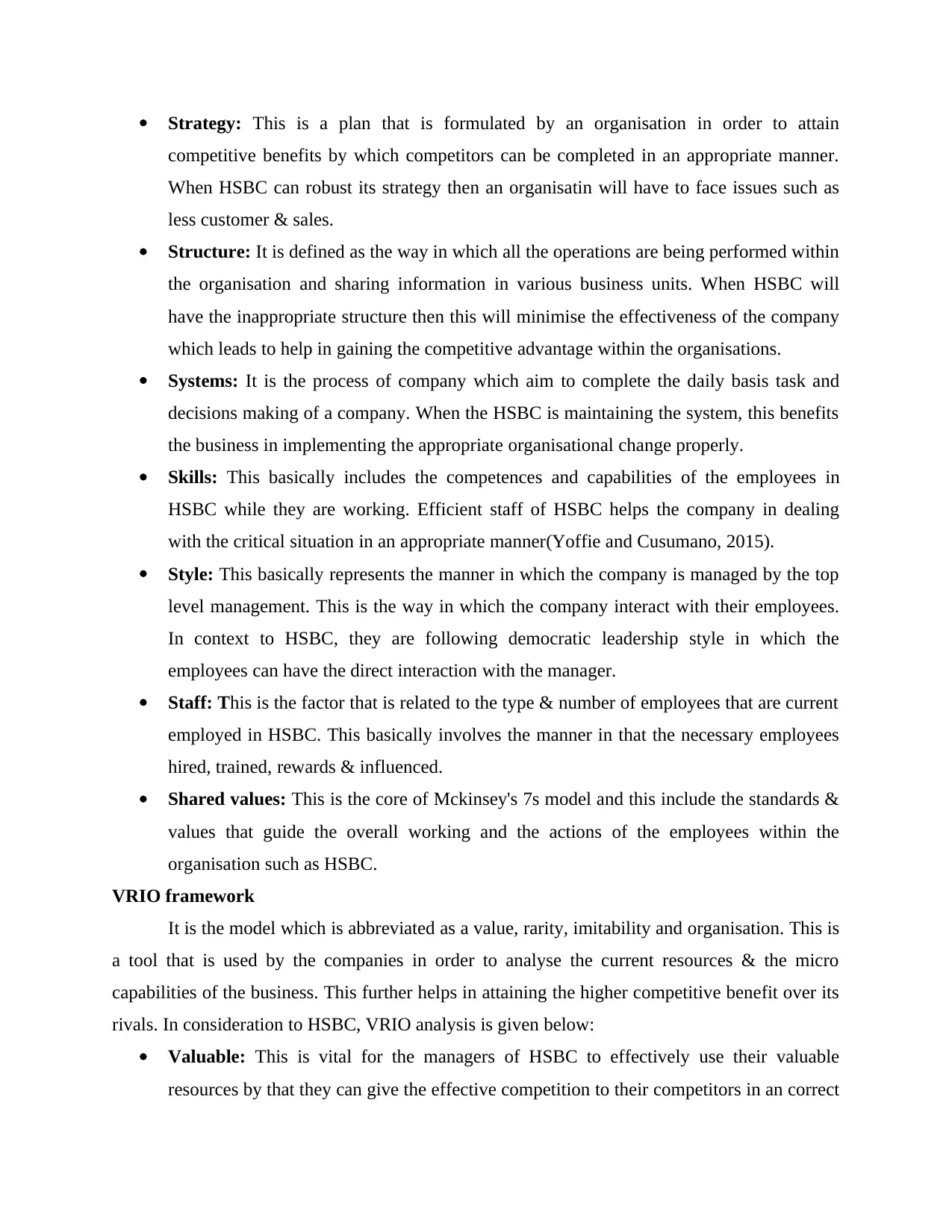
Strategy: This is a plan that is formulated by an organisation in order to attain
competitive benefits by which competitors can be completed in an appropriate manner.
When HSBC can robust its strategy then an organisatin will have to face issues such as
less customer & sales.
Structure: It is defined as the way in which all the operations are being performed within
the organisation and sharing information in various business units. When HSBC will
have the inappropriate structure then this will minimise the effectiveness of the company
which leads to help in gaining the competitive advantage within the organisations.
Systems: It is the process of company which aim to complete the daily basis task and
decisions making of a company. When the HSBC is maintaining the system, this benefits
the business in implementing the appropriate organisational change properly.
Skills: This basically includes the competences and capabilities of the employees in
HSBC while they are working. Efficient staff of HSBC helps the company in dealing
with the critical situation in an appropriate manner(Yoffie and Cusumano, 2015).
Style: This basically represents the manner in which the company is managed by the top
level management. This is the way in which the company interact with their employees.
In context to HSBC, they are following democratic leadership style in which the
employees can have the direct interaction with the manager.
Staff: This is the factor that is related to the type & number of employees that are current
employed in HSBC. This basically involves the manner in that the necessary employees
hired, trained, rewards & influenced.
Shared values: This is the core of Mckinsey's 7s model and this include the standards &
values that guide the overall working and the actions of the employees within the
organisation such as HSBC.
VRIO framework
It is the model which is abbreviated as a value, rarity, imitability and organisation. This is
a tool that is used by the companies in order to analyse the current resources & the micro
capabilities of the business. This further helps in attaining the higher competitive benefit over its
rivals. In consideration to HSBC, VRIO analysis is given below:
Valuable: This is vital for the managers of HSBC to effectively use their valuable
resources by that they can give the effective competition to their competitors in an correct
competitive benefits by which competitors can be completed in an appropriate manner.
When HSBC can robust its strategy then an organisatin will have to face issues such as
less customer & sales.
Structure: It is defined as the way in which all the operations are being performed within
the organisation and sharing information in various business units. When HSBC will
have the inappropriate structure then this will minimise the effectiveness of the company
which leads to help in gaining the competitive advantage within the organisations.
Systems: It is the process of company which aim to complete the daily basis task and
decisions making of a company. When the HSBC is maintaining the system, this benefits
the business in implementing the appropriate organisational change properly.
Skills: This basically includes the competences and capabilities of the employees in
HSBC while they are working. Efficient staff of HSBC helps the company in dealing
with the critical situation in an appropriate manner(Yoffie and Cusumano, 2015).
Style: This basically represents the manner in which the company is managed by the top
level management. This is the way in which the company interact with their employees.
In context to HSBC, they are following democratic leadership style in which the
employees can have the direct interaction with the manager.
Staff: This is the factor that is related to the type & number of employees that are current
employed in HSBC. This basically involves the manner in that the necessary employees
hired, trained, rewards & influenced.
Shared values: This is the core of Mckinsey's 7s model and this include the standards &
values that guide the overall working and the actions of the employees within the
organisation such as HSBC.
VRIO framework
It is the model which is abbreviated as a value, rarity, imitability and organisation. This is
a tool that is used by the companies in order to analyse the current resources & the micro
capabilities of the business. This further helps in attaining the higher competitive benefit over its
rivals. In consideration to HSBC, VRIO analysis is given below:
Valuable: This is vital for the managers of HSBC to effectively use their valuable
resources by that they can give the effective competition to their competitors in an correct
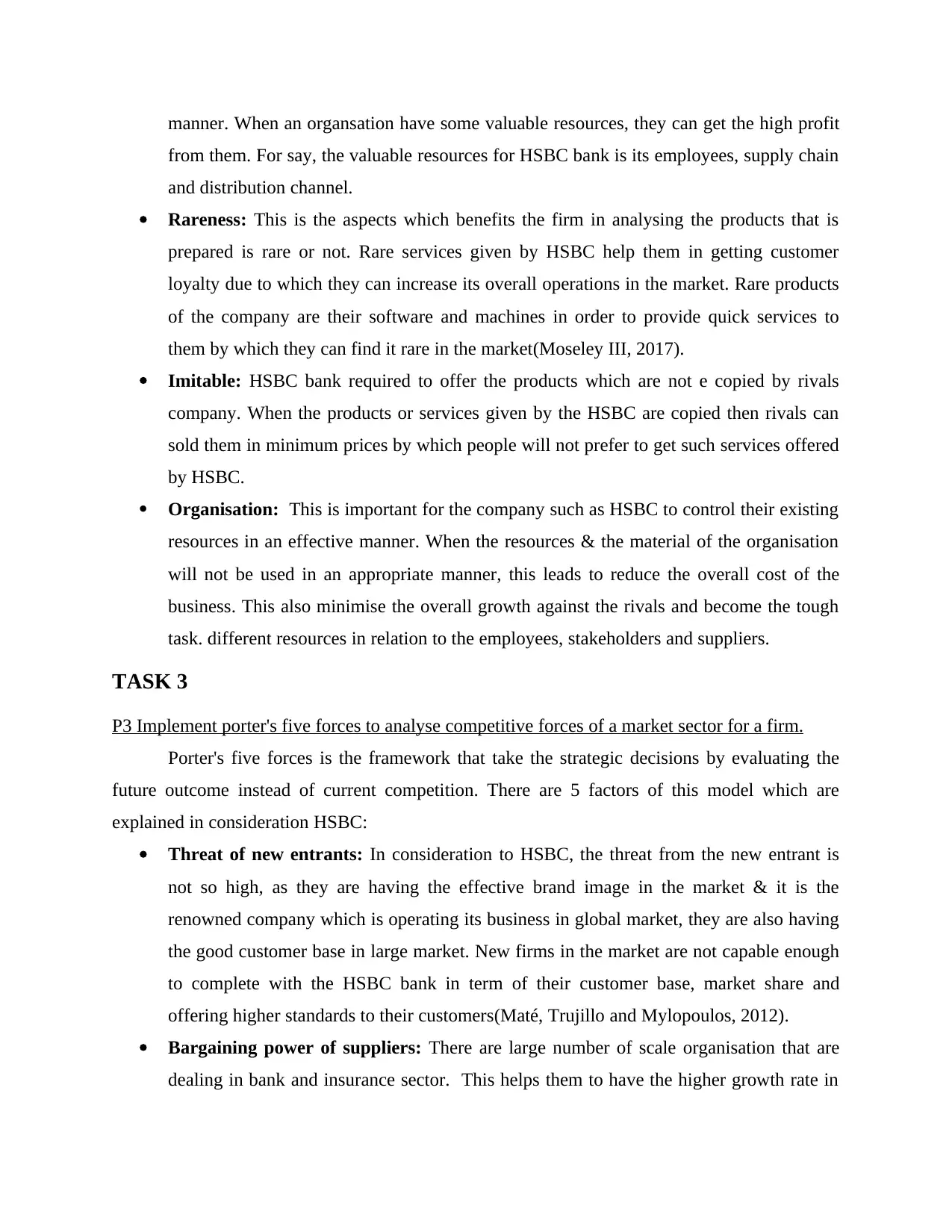
manner. When an organsation have some valuable resources, they can get the high profit
from them. For say, the valuable resources for HSBC bank is its employees, supply chain
and distribution channel.
Rareness: This is the aspects which benefits the firm in analysing the products that is
prepared is rare or not. Rare services given by HSBC help them in getting customer
loyalty due to which they can increase its overall operations in the market. Rare products
of the company are their software and machines in order to provide quick services to
them by which they can find it rare in the market(Moseley III, 2017).
Imitable: HSBC bank required to offer the products which are not e copied by rivals
company. When the products or services given by the HSBC are copied then rivals can
sold them in minimum prices by which people will not prefer to get such services offered
by HSBC.
Organisation: This is important for the company such as HSBC to control their existing
resources in an effective manner. When the resources & the material of the organisation
will not be used in an appropriate manner, this leads to reduce the overall cost of the
business. This also minimise the overall growth against the rivals and become the tough
task. different resources in relation to the employees, stakeholders and suppliers.
TASK 3
P3 Implement porter's five forces to analyse competitive forces of a market sector for a firm.
Porter's five forces is the framework that take the strategic decisions by evaluating the
future outcome instead of current competition. There are 5 factors of this model which are
explained in consideration HSBC:
Threat of new entrants: In consideration to HSBC, the threat from the new entrant is
not so high, as they are having the effective brand image in the market & it is the
renowned company which is operating its business in global market, they are also having
the good customer base in large market. New firms in the market are not capable enough
to complete with the HSBC bank in term of their customer base, market share and
offering higher standards to their customers(Maté, Trujillo and Mylopoulos, 2012).
Bargaining power of suppliers: There are large number of scale organisation that are
dealing in bank and insurance sector. This helps them to have the higher growth rate in
from them. For say, the valuable resources for HSBC bank is its employees, supply chain
and distribution channel.
Rareness: This is the aspects which benefits the firm in analysing the products that is
prepared is rare or not. Rare services given by HSBC help them in getting customer
loyalty due to which they can increase its overall operations in the market. Rare products
of the company are their software and machines in order to provide quick services to
them by which they can find it rare in the market(Moseley III, 2017).
Imitable: HSBC bank required to offer the products which are not e copied by rivals
company. When the products or services given by the HSBC are copied then rivals can
sold them in minimum prices by which people will not prefer to get such services offered
by HSBC.
Organisation: This is important for the company such as HSBC to control their existing
resources in an effective manner. When the resources & the material of the organisation
will not be used in an appropriate manner, this leads to reduce the overall cost of the
business. This also minimise the overall growth against the rivals and become the tough
task. different resources in relation to the employees, stakeholders and suppliers.
TASK 3
P3 Implement porter's five forces to analyse competitive forces of a market sector for a firm.
Porter's five forces is the framework that take the strategic decisions by evaluating the
future outcome instead of current competition. There are 5 factors of this model which are
explained in consideration HSBC:
Threat of new entrants: In consideration to HSBC, the threat from the new entrant is
not so high, as they are having the effective brand image in the market & it is the
renowned company which is operating its business in global market, they are also having
the good customer base in large market. New firms in the market are not capable enough
to complete with the HSBC bank in term of their customer base, market share and
offering higher standards to their customers(Maté, Trujillo and Mylopoulos, 2012).
Bargaining power of suppliers: There are large number of scale organisation that are
dealing in bank and insurance sector. This helps them to have the higher growth rate in
⊘ This is a preview!⊘
Do you want full access?
Subscribe today to unlock all pages.

Trusted by 1+ million students worldwide
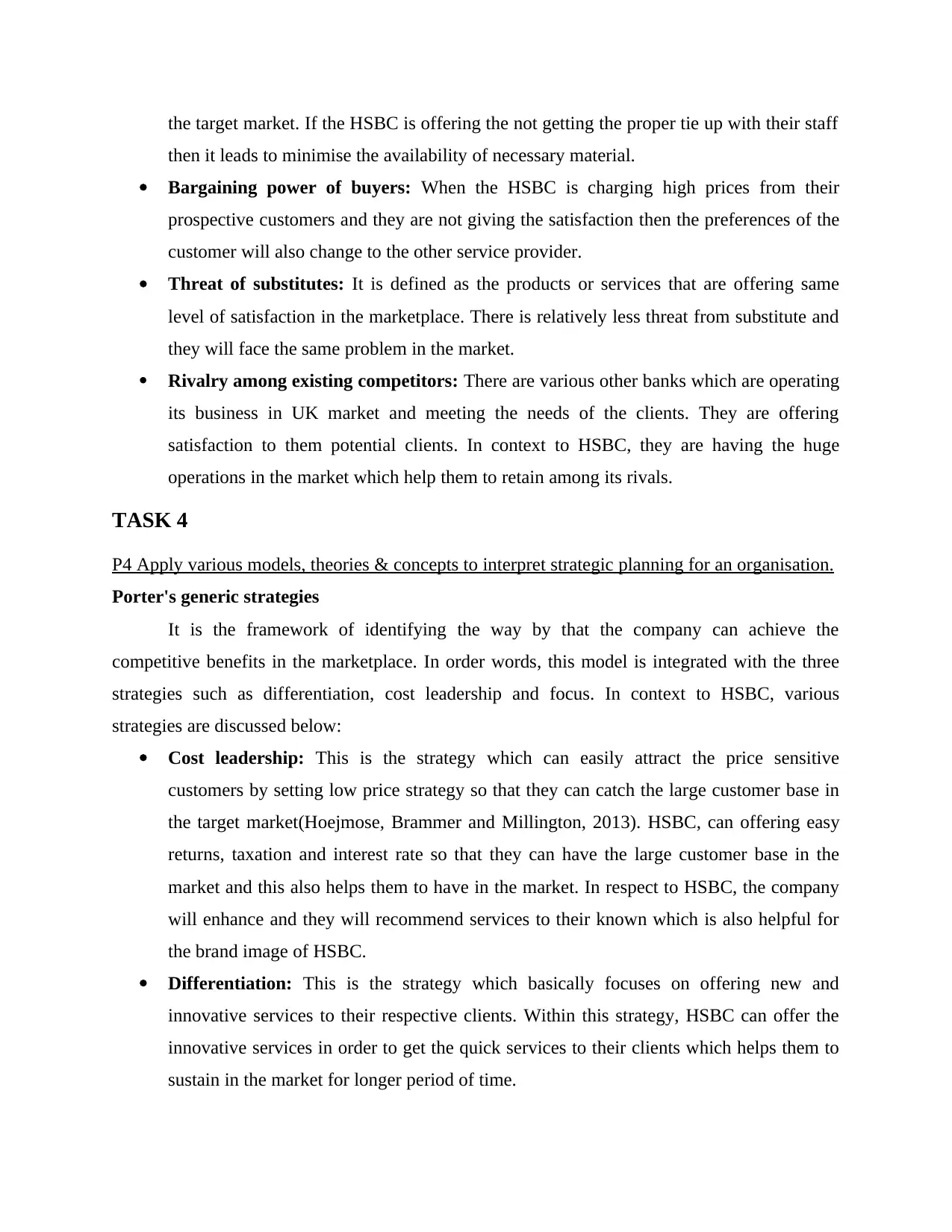
the target market. If the HSBC is offering the not getting the proper tie up with their staff
then it leads to minimise the availability of necessary material.
Bargaining power of buyers: When the HSBC is charging high prices from their
prospective customers and they are not giving the satisfaction then the preferences of the
customer will also change to the other service provider.
Threat of substitutes: It is defined as the products or services that are offering same
level of satisfaction in the marketplace. There is relatively less threat from substitute and
they will face the same problem in the market.
Rivalry among existing competitors: There are various other banks which are operating
its business in UK market and meeting the needs of the clients. They are offering
satisfaction to them potential clients. In context to HSBC, they are having the huge
operations in the market which help them to retain among its rivals.
TASK 4
P4 Apply various models, theories & concepts to interpret strategic planning for an organisation.
Porter's generic strategies
It is the framework of identifying the way by that the company can achieve the
competitive benefits in the marketplace. In order words, this model is integrated with the three
strategies such as differentiation, cost leadership and focus. In context to HSBC, various
strategies are discussed below:
Cost leadership: This is the strategy which can easily attract the price sensitive
customers by setting low price strategy so that they can catch the large customer base in
the target market(Hoejmose, Brammer and Millington, 2013). HSBC, can offering easy
returns, taxation and interest rate so that they can have the large customer base in the
market and this also helps them to have in the market. In respect to HSBC, the company
will enhance and they will recommend services to their known which is also helpful for
the brand image of HSBC.
Differentiation: This is the strategy which basically focuses on offering new and
innovative services to their respective clients. Within this strategy, HSBC can offer the
innovative services in order to get the quick services to their clients which helps them to
sustain in the market for longer period of time.
then it leads to minimise the availability of necessary material.
Bargaining power of buyers: When the HSBC is charging high prices from their
prospective customers and they are not giving the satisfaction then the preferences of the
customer will also change to the other service provider.
Threat of substitutes: It is defined as the products or services that are offering same
level of satisfaction in the marketplace. There is relatively less threat from substitute and
they will face the same problem in the market.
Rivalry among existing competitors: There are various other banks which are operating
its business in UK market and meeting the needs of the clients. They are offering
satisfaction to them potential clients. In context to HSBC, they are having the huge
operations in the market which help them to retain among its rivals.
TASK 4
P4 Apply various models, theories & concepts to interpret strategic planning for an organisation.
Porter's generic strategies
It is the framework of identifying the way by that the company can achieve the
competitive benefits in the marketplace. In order words, this model is integrated with the three
strategies such as differentiation, cost leadership and focus. In context to HSBC, various
strategies are discussed below:
Cost leadership: This is the strategy which can easily attract the price sensitive
customers by setting low price strategy so that they can catch the large customer base in
the target market(Hoejmose, Brammer and Millington, 2013). HSBC, can offering easy
returns, taxation and interest rate so that they can have the large customer base in the
market and this also helps them to have in the market. In respect to HSBC, the company
will enhance and they will recommend services to their known which is also helpful for
the brand image of HSBC.
Differentiation: This is the strategy which basically focuses on offering new and
innovative services to their respective clients. Within this strategy, HSBC can offer the
innovative services in order to get the quick services to their clients which helps them to
sustain in the market for longer period of time.
Paraphrase This Document
Need a fresh take? Get an instant paraphrase of this document with our AI Paraphraser

Focus: This is the respective strategy which has two aspects i. e., cost focuses &
differentiation focus. In respect to cost focus, HSBC basically focuses on offering the
less prices to niche market. On other hand, in differentiation focus, they are focuses on
offering unique services to their niche market so that they can handle the different types
of customer with unique strategy so that they can retain in the business for longer period
of time.
Bowman's strategic clock
It is the framework that helps the business in exploring the appropriate strategic
positioning in the market such as HSBC can position it self as the top leading brand over its
competitors so that they can achieve the business in an effective manner. There are following
aspects of this model which are describe below:
Low price and low value added: There is less competitive aspects for HSBC as they are
offering the general services to their customers and also having perceive less value for the
goods even if their services are not less.
Low price: In consideration to HSBC, they can position its brand as the leader in the by
minimising its services charges. This helps them to attract large customer group and also
ensure the operations at larger scale in the market(Drnevich and Croson, 2013).
Hybrid: This is the strategy which basically includes the elements of low price and the
differentiated services. This helps the HSBC to generate higher revenue and profitability
by which they can sustain in the market.
Differentiation: In this strategy, this helps the company to sustain in the market by
offering unique services to their clients so that they can retain to their brand in long run.
Focused differentiation: There are services which needs to rendered to the specific
category of client at low prices or tax so that they can retain their brand as their loyal
customers. This helps them to be the global brand in the large market.
Risky high margins: this is the strategy in which the company have to face huge risk
that can leads to results in the failure of the business. HSBC can get and set the higher
prices of their services so that they can establish the good brand image and ensure the
higher revenue as well.
Monopoly pricing: In this market place, only one business offer the services and these
are not rendered by other business. They are not concerned about the prices or the
differentiation focus. In respect to cost focus, HSBC basically focuses on offering the
less prices to niche market. On other hand, in differentiation focus, they are focuses on
offering unique services to their niche market so that they can handle the different types
of customer with unique strategy so that they can retain in the business for longer period
of time.
Bowman's strategic clock
It is the framework that helps the business in exploring the appropriate strategic
positioning in the market such as HSBC can position it self as the top leading brand over its
competitors so that they can achieve the business in an effective manner. There are following
aspects of this model which are describe below:
Low price and low value added: There is less competitive aspects for HSBC as they are
offering the general services to their customers and also having perceive less value for the
goods even if their services are not less.
Low price: In consideration to HSBC, they can position its brand as the leader in the by
minimising its services charges. This helps them to attract large customer group and also
ensure the operations at larger scale in the market(Drnevich and Croson, 2013).
Hybrid: This is the strategy which basically includes the elements of low price and the
differentiated services. This helps the HSBC to generate higher revenue and profitability
by which they can sustain in the market.
Differentiation: In this strategy, this helps the company to sustain in the market by
offering unique services to their clients so that they can retain to their brand in long run.
Focused differentiation: There are services which needs to rendered to the specific
category of client at low prices or tax so that they can retain their brand as their loyal
customers. This helps them to be the global brand in the large market.
Risky high margins: this is the strategy in which the company have to face huge risk
that can leads to results in the failure of the business. HSBC can get and set the higher
prices of their services so that they can establish the good brand image and ensure the
higher revenue as well.
Monopoly pricing: In this market place, only one business offer the services and these
are not rendered by other business. They are not concerned about the prices or the
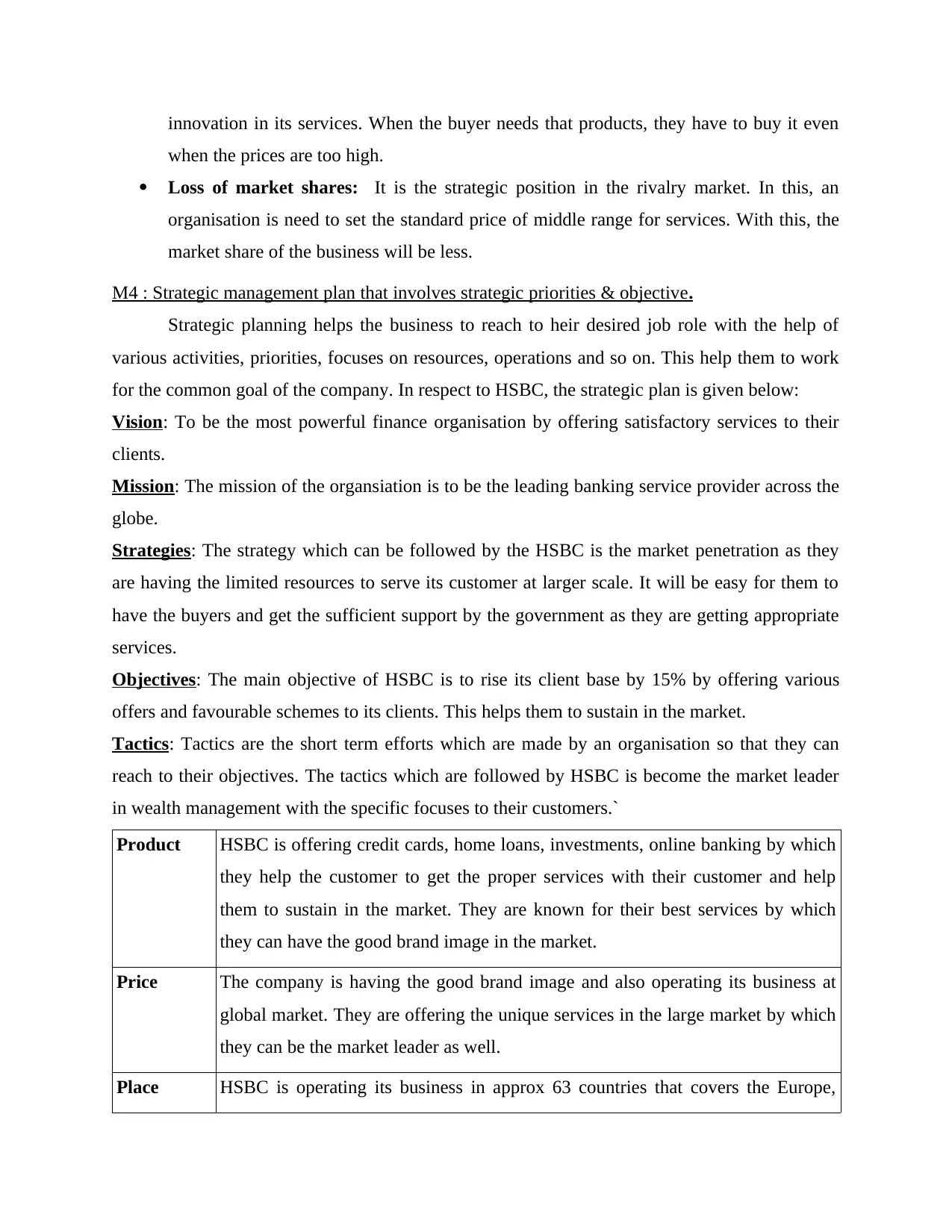
innovation in its services. When the buyer needs that products, they have to buy it even
when the prices are too high.
Loss of market shares: It is the strategic position in the rivalry market. In this, an
organisation is need to set the standard price of middle range for services. With this, the
market share of the business will be less.
M4 : Strategic management plan that involves strategic priorities & objective.
Strategic planning helps the business to reach to heir desired job role with the help of
various activities, priorities, focuses on resources, operations and so on. This help them to work
for the common goal of the company. In respect to HSBC, the strategic plan is given below:
Vision: To be the most powerful finance organisation by offering satisfactory services to their
clients.
Mission: The mission of the organsiation is to be the leading banking service provider across the
globe.
Strategies: The strategy which can be followed by the HSBC is the market penetration as they
are having the limited resources to serve its customer at larger scale. It will be easy for them to
have the buyers and get the sufficient support by the government as they are getting appropriate
services.
Objectives: The main objective of HSBC is to rise its client base by 15% by offering various
offers and favourable schemes to its clients. This helps them to sustain in the market.
Tactics: Tactics are the short term efforts which are made by an organisation so that they can
reach to their objectives. The tactics which are followed by HSBC is become the market leader
in wealth management with the specific focuses to their customers.`
Product HSBC is offering credit cards, home loans, investments, online banking by which
they help the customer to get the proper services with their customer and help
them to sustain in the market. They are known for their best services by which
they can have the good brand image in the market.
Price The company is having the good brand image and also operating its business at
global market. They are offering the unique services in the large market by which
they can be the market leader as well.
Place HSBC is operating its business in approx 63 countries that covers the Europe,
when the prices are too high.
Loss of market shares: It is the strategic position in the rivalry market. In this, an
organisation is need to set the standard price of middle range for services. With this, the
market share of the business will be less.
M4 : Strategic management plan that involves strategic priorities & objective.
Strategic planning helps the business to reach to heir desired job role with the help of
various activities, priorities, focuses on resources, operations and so on. This help them to work
for the common goal of the company. In respect to HSBC, the strategic plan is given below:
Vision: To be the most powerful finance organisation by offering satisfactory services to their
clients.
Mission: The mission of the organsiation is to be the leading banking service provider across the
globe.
Strategies: The strategy which can be followed by the HSBC is the market penetration as they
are having the limited resources to serve its customer at larger scale. It will be easy for them to
have the buyers and get the sufficient support by the government as they are getting appropriate
services.
Objectives: The main objective of HSBC is to rise its client base by 15% by offering various
offers and favourable schemes to its clients. This helps them to sustain in the market.
Tactics: Tactics are the short term efforts which are made by an organisation so that they can
reach to their objectives. The tactics which are followed by HSBC is become the market leader
in wealth management with the specific focuses to their customers.`
Product HSBC is offering credit cards, home loans, investments, online banking by which
they help the customer to get the proper services with their customer and help
them to sustain in the market. They are known for their best services by which
they can have the good brand image in the market.
Price The company is having the good brand image and also operating its business at
global market. They are offering the unique services in the large market by which
they can be the market leader as well.
Place HSBC is operating its business in approx 63 countries that covers the Europe,
⊘ This is a preview!⊘
Do you want full access?
Subscribe today to unlock all pages.

Trusted by 1+ million students worldwide
1 out of 15
Related Documents
Your All-in-One AI-Powered Toolkit for Academic Success.
+13062052269
info@desklib.com
Available 24*7 on WhatsApp / Email
![[object Object]](/_next/static/media/star-bottom.7253800d.svg)
Unlock your academic potential
Copyright © 2020–2025 A2Z Services. All Rights Reserved. Developed and managed by ZUCOL.




